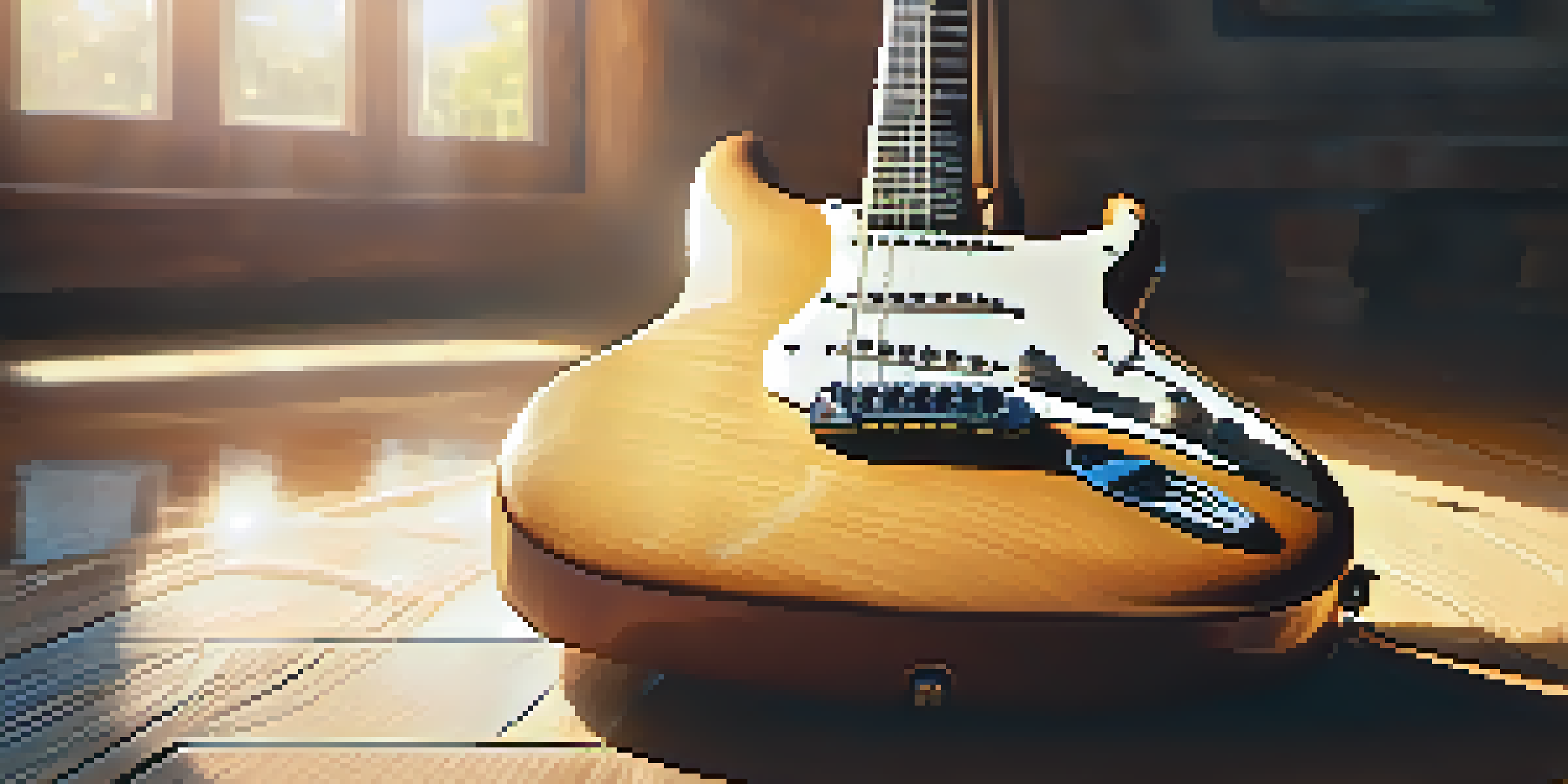Developing Your Own Style with Guitar Solo Techniques

Understanding the Basics of Guitar Solos
Before you dive into crafting your unique sound, it’s essential to grasp the fundamentals of guitar solos. This includes understanding scales, arpeggios, and the different techniques that can be employed. Think of learning these basics as laying the groundwork for a house; without a solid foundation, your creative structure won't stand tall.
Music is the shorthand of emotion.
Scales are particularly important as they provide the notes you'll use to create your solos. For instance, the pentatonic scale is a go-to for many guitarists because of its versatility and ease of use. Familiarizing yourself with these scales can help you express emotions through your playing, just like how a painter uses colors to convey feelings on canvas.
Once you have a handle on the basics, you’ll find it easier to explore and develop your own style. It’s all about blending what you learn with your personal flair. Remember, every great guitarist has their own story to tell through their music, so embrace the journey!
Experimenting with Different Techniques
Now that you've established a foundation, it's time to experiment with various guitar solo techniques to find what resonates with you. Techniques like hammer-ons, pull-offs, and slides can add a unique flavor to your solos. Imagine each technique as a different spice; a little can enhance the overall dish, while too much can overwhelm it.

For example, using hammer-ons can create a fluid sound that moves seamlessly between notes. This can evoke a sense of urgency or excitement in your solos. On the other hand, incorporating slides can provide a smooth, legato feel, making your playing more expressive and dynamic.
Master the Basics of Solos
Understanding scales and techniques forms the foundation for crafting unique guitar solos.
Don’t be afraid to mix and match these techniques to create your own signature sound. As you experiment, keep a journal or record yourself to track your progress. This way, you can revisit ideas that work and refine those that don’t, allowing your style to evolve naturally.
Incorporating Emotion into Your Solos
One key aspect of developing your style is learning to infuse emotion into your guitar solos. Music is a powerful form of expression, and your solos should tell a story or convey a feeling. Think about how different notes and techniques can evoke various emotions, much like how a movie score enhances the narrative of a film.
To be a great musician, you have to be willing to fail spectacularly.
For instance, if you're playing a melancholic piece, you might opt for longer, sustained notes that create a sense of longing. Conversely, a high-energy rock solo might utilize faster runs or aggressive techniques to evoke excitement and adrenaline. By consciously choosing how to express these feelings, you’ll make your solos more impactful.
Listening to your favorite guitarists can also provide inspiration on how to convey emotion effectively. Pay attention to their phrasing and dynamics, and try to incorporate similar techniques into your own playing. Over time, you'll develop a deeper understanding of how emotion and music intertwine.
Finding Inspiration from Other Genres
To truly develop your own guitar style, consider exploring various musical genres. Each genre has unique characteristics that can inspire new ideas and techniques for your solos. For example, country music often features intricate bends and twang, while jazz incorporates complex chords and improvisation.
By listening to and studying different styles, you can borrow elements that resonate with you. This blend of influences can lead to a more innovative and distinctive sound. Think of it as mixing different colors on a palette; the result can be a vibrant masterpiece that reflects your individuality.
Infuse Emotion into Playing
Conveying emotion through your solos enhances their impact and connects with your audience.
Don’t hesitate to experiment with genres outside your comfort zone. You might discover unexpected techniques or creative approaches that elevate your playing and help you stand out as a guitarist. Remember, the beauty of music lies in its diversity, and your unique style can emerge from this exploration.
Developing Your Signature Sound
Once you’ve gathered inspiration and honed your techniques, it's time to focus on crafting your signature sound. This involves combining what you've learned and experimenting with different combinations of techniques, scales, and influences. It’s like cooking; you have to find the right balance of ingredients to create a dish that is uniquely yours.
Start by taking elements from your favorite guitarists and putting your spin on them. This could mean altering a classic riff or adding a personal flourish to a well-known technique. By doing this, you’ll create a sound that feels authentic and true to your musical identity.
Remember, developing a signature sound takes time and experimentation. Be patient with yourself and allow your style to evolve naturally. Over time, as you refine your approach, you’ll find your voice shining through your solos.
Practicing with Purpose and Consistency
To truly develop your unique guitar style, consistent and purposeful practice is essential. It's not just about playing the same scales or songs repeatedly; it’s about focusing on the aspects you want to improve and experimenting with them. Think of practice as a workout; the more targeted your efforts, the stronger your skills will become.
Set specific goals for each practice session, whether it's mastering a new technique or writing a solo. This structured approach can lead to more productive sessions and a greater sense of accomplishment. Over time, you’ll notice improvements in your playing that contribute to your developing style.
Share Your Unique Sound
Performing and sharing your music fosters community and helps solidify your identity as a guitarist.
Additionally, consider incorporating improvisation into your practice routine. This not only helps you think on your feet but also encourages creativity. By consistently pushing your boundaries, you'll discover new ideas that contribute to your evolving sound.
Sharing Your Style with Others
Once you feel confident in your developing style, it’s time to share it with the world. This could mean performing at open mics, collaborating with other musicians, or even posting videos online. Sharing your music is an essential step in solidifying your identity as a guitarist and allows you to connect with others who appreciate your unique sound.
Receiving feedback from others can also be invaluable in refining your style. Constructive criticism can help you identify areas for improvement, while positive reinforcement can boost your confidence. Remember, every musician has their own perspective, and their insights can provide fresh ideas for your playing.

Ultimately, sharing your music creates a sense of community and belonging. You'll find that there are others out there who resonate with your style, and this connection can be incredibly rewarding. Embrace the journey of sharing your music, and watch as your style continues to evolve.